
|
xTuple ERP Reference Guide |
To create a new purchase order line item, select the button. The following screen will appear:
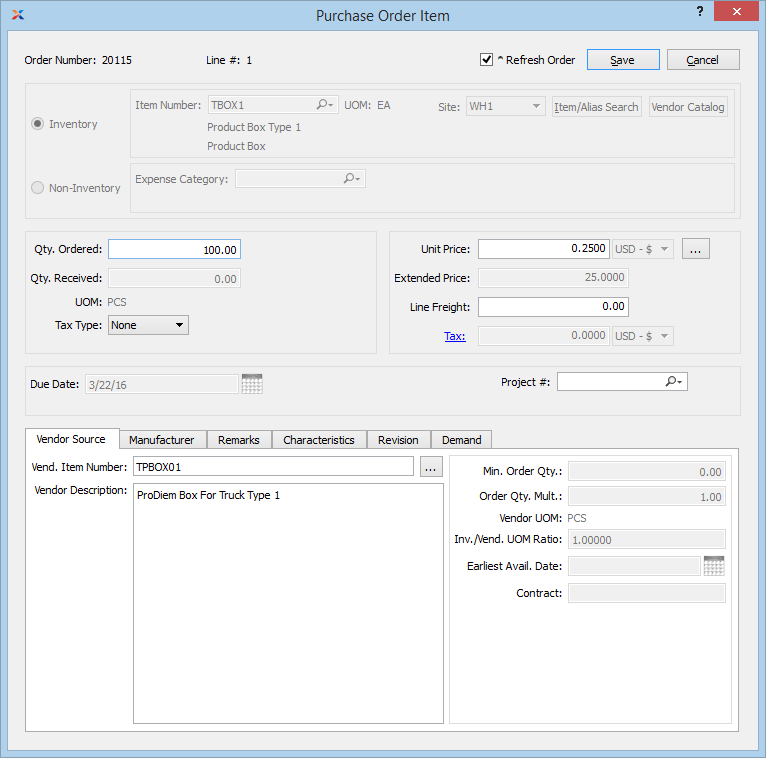
When creating a new purchase order line item, you are presented with the following options:
If the line item was created from a linked sales order, the details will be updated whenever the sales order is updated.
Displays the purchase order number specified in the New Purchase Order screen.
The application automatically assigns line numbers to purchase order line items. Numbering begins at one (1) and increases automatically in increments of one.
Select to indicate you want the purchase order header to be refreshed immediately in the background. When the header is refreshed immediately, you will be able to see the rows of line items being added to the order. However, this feature can impact performance when entering purchase order line items. If you are experiencing performance issues, you should not select this option. The purchase order will be refreshed when you close the Purchase Order Line Item screen.
If the item being purchased is an inventory item, select this option and specify the following:
Enter the item number of the item you want to add to the purchase order. You may also enter manufactured items that you normally make, but you occasionally buy—as long as the item site for the manufactured item also indicates it may be purchased.
Specify the site where the item is supplied at. For purchased items to be included on a purchase order, their item site record must indicate they are purchased for the site.
Advanced item search (AIS) is a feature designed specifically with distribution in mind. This feature allows distributors and end users to quickly search for both items and item aliases—as well as current inventory levels—filtering every keystroke. From this screen you also have the ability to create an item alias.
When using the AIS, you must enter at least three characters (i.e., numbers, letters or a combination of both) before any search results will be returned. This is for speed of performance reasons.
Select to use the External Vendor Catalog screen to view items as they appear within the various vendor catalogs you are subscribed to.
If the item being purchased is a non-inventory item, select this option and specify the following:
Select an expense category to assign the non-inventory item to.
Enter the quantity of the specified item to be ordered.
Displays quantity received from quantity ordered.
Unit of measure (UOM) item is being ordered in.
Select a tax type.
Enter the unit price for the specified item—or use the lookup—feature to look up pricing information, including pricing related to quantity breaks.
Displays the extended price. The extended price for a line item is based on the quantity ordered multiplied by the unit price.
Enter the amount of freight charges for the entire line item quantity. The system automatically calculates the per unit freight charge by dividing the line item freight amount by the line item quantity. This per unit freight charge is needed when receiving or vouchering quantities less than the original quantity ordered. Line item freight is distinguished from miscellaneous freight, which applies to the purchase order as a whole.
Displays the calculated tax amount.
Specify date when order is expected to be received. For drop ship orders, the due date for purchase order items will be the same as the linked sales order's scheduled date.
If your system is configured to use projects, select a project number to associate with the purchase order line item. If the purchase order line item is being created from a purchase request driven by sales order demand—and the parent sales order had a project number associated with it—then the project number from the parent sales order will automatically be entered here. In this way, sales orders and purchase order line items may be linked to the same project.
When you have the xTuple Project Accounting package installed—and you link a project to the purchase order line item—transactions related to the purchase order line item will include the project number as the final segment of affected G/L account numbers. Account numbers related to the following transactions will include project number as the final segment: post receipt, correct receipt, and post purchase order return. If there are cost variances when vouchering, the purchase variance account will also inherit the project number segment.
If item source information exists for an inventory item, that information will display automatically here. For non-inventory items, you should specify an item number and item description.
Enter the item number the vendor assigns to the specified item.
Enter the description the vendor uses to describe to the specified item.
For inventory items only, displays the minimum order quantity for the specified item and the specified vendor. Minimum order quantities are established in the Item Source master.
For inventory items only, displays the order multiple for the specified item and the specified vendor. Order multiples are established in the Item Source master.
For inventory items only, displays the UOM used by the vendor for the specified item.
For inventory items only, displays the ratio between inventory and vendor UOM. If needed, you can override the value of the ratio to fit the needs of a particular order. Any overrides are for this order only. Changes are not written to the item source record.
The inventory/vendor UOM ratio specifies the ratio between inventory and vendor UOM. For example, if you store an item in single units, but a vendor sells you the item in cases of 12, then the ratio would be 12—or 12:1. When an inv./vend. ratio is specified, the system allows you to purchase items using the vendor's UOM; however, when the items are received, the system will automatically convert the inventory to your inventory UOM.
For inventory items only, displays the earliest due date for the specified item.
Displays the standard contract quantity for the item source, if it exists.
To add manufacturer information to the purchase order item, select the tab. The following screen will appear:
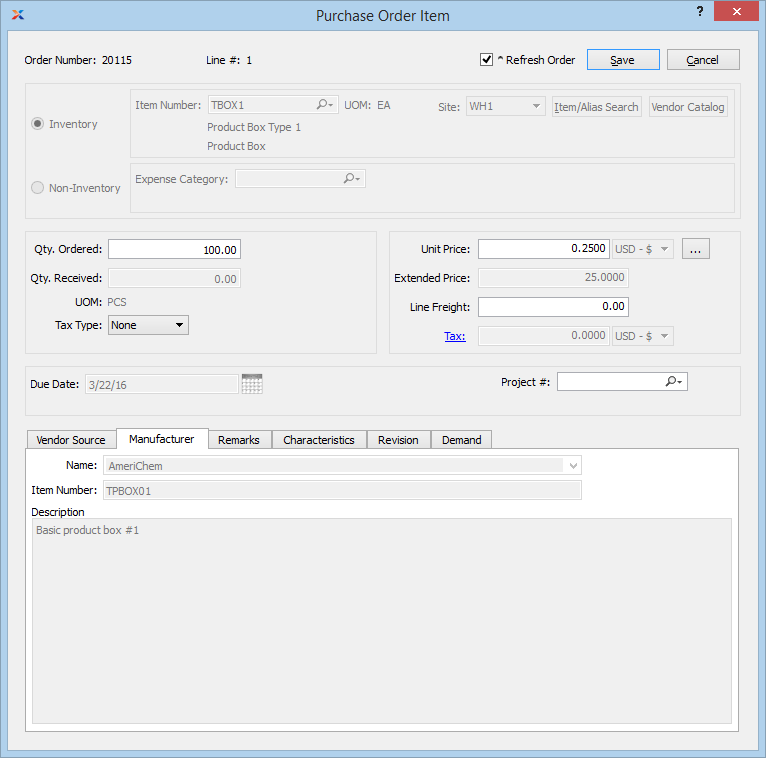
When entering manufacturer information to a purchase order item, you are presented with the following options:
The name of the manufacturer who creates the item.
The item number the manufacturer uses to identify the component.
The description the manufacturer uses to describe the item.
To add miscellaneous remarks to the purchase order item, select the tab. The following screen will appear:
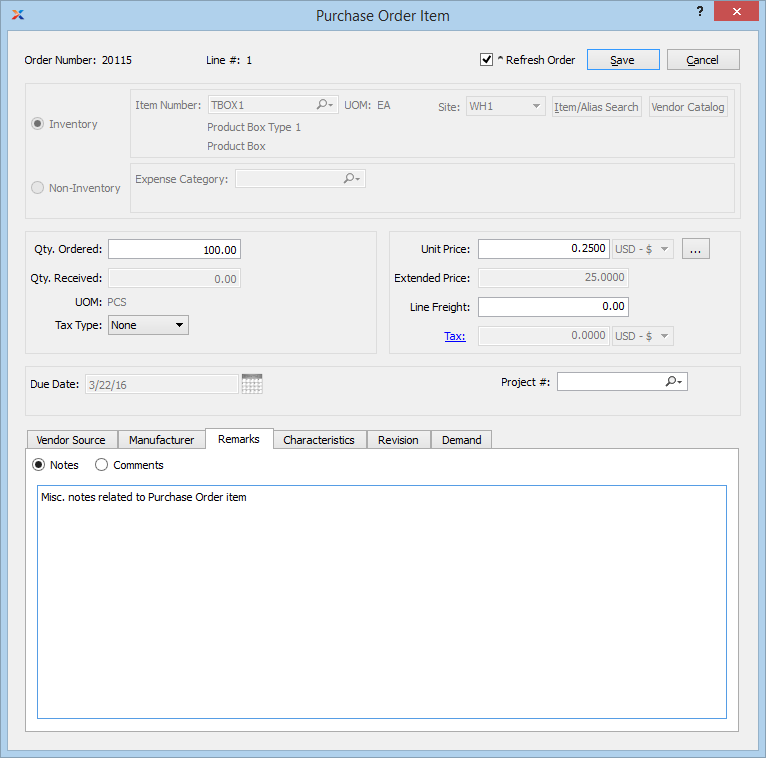
When entering miscellaneous remarks to a purchase order item, you are presented with the following options:
This is a scrolling text field with word-wrapping for entering notes related to the purchase order line item.
To view system-generated comments associated with an item—or to add new comments of your own—select the option.
If an item has characteristics associated with it, you have the option of linking those characteristics to a purchase order item. In the case where sales order demand generates a purchase request, item characteristics and values inherited from the sales order will already be linked to the purchase order. Ultimately, characteristics associated with a purchase order item may be printed on the purchase order report.
You can link characteristics and values to an item by using the Item master. Once entered, these characteristics and values will be available to users entering purchase order items.
To specify or edit characteristics for a purchase order item, select the tab at the bottom of the screen. The following screen will appear:
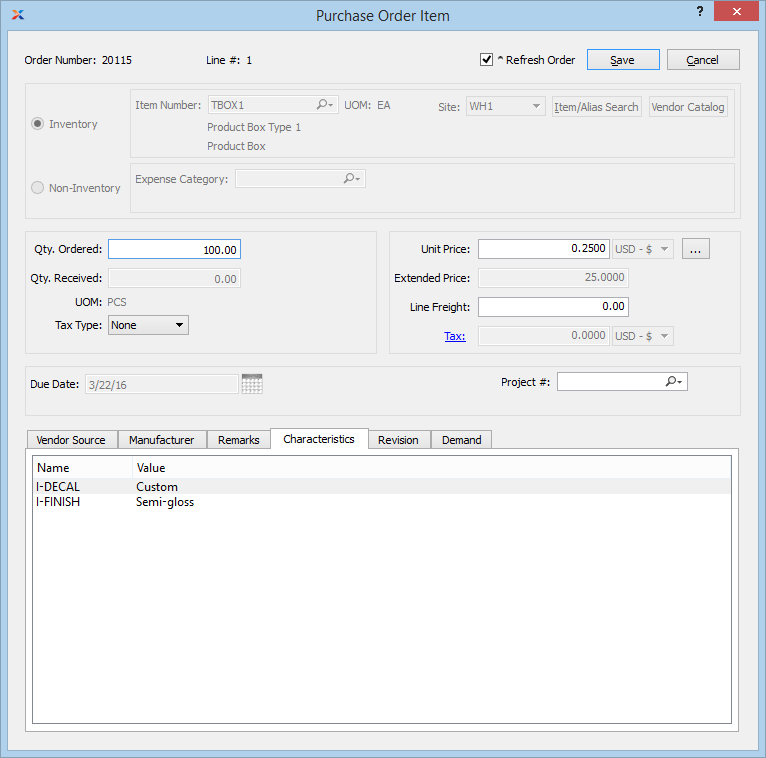
To create a new characteristic for your current context, select the button from the characteristics list. The following screen will appear:
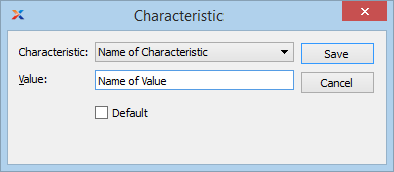
When creating a new characteristic, you are presented with the following options:
Select a characteristic from the list of characteristics available for your current context. To learn more about how characteristics are linked to specific contexts, please see Section 9.2.2.1, “Characteristic”.
Enter a value to associate with the characteristic.
In some contexts, the Default option will appear. Select if the value entered is the default value for the specified characteristic. Default values will always be listed first where characteristics are used.
When ordering purchased items, you have the option to specify which revision of the item's bill of materials (BOM) and routing you want to buy. By default, the active revision will be used. To specify revision information for a purchase order item, select the tab. The following screen will appear:
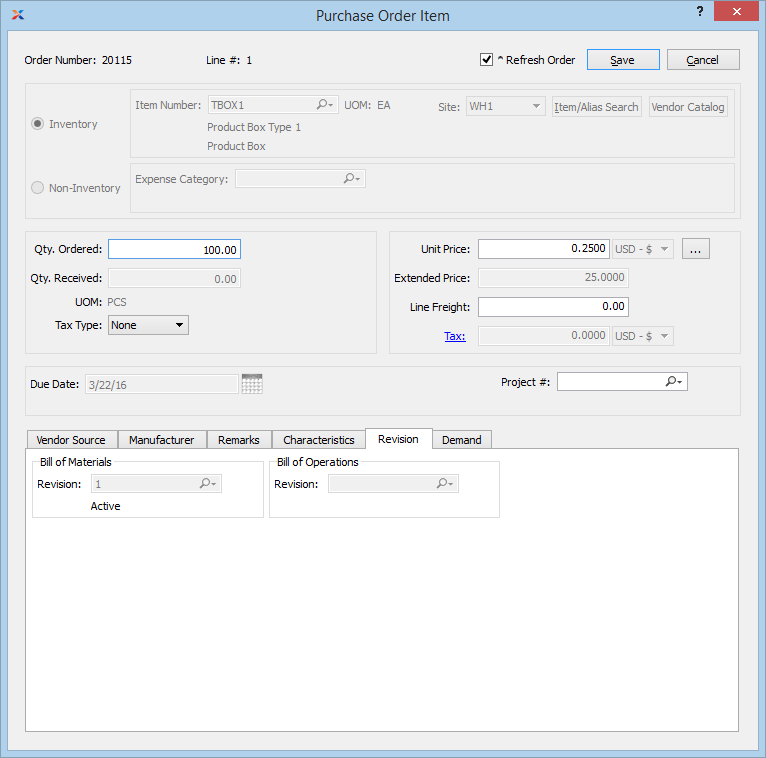
You may create purchase order items for pending revisions. For purchase order purposes, a pending revision is considered to be the same as an inactive revision. The revision status of a pending revision will not be changed if a purchase order item is created for it.
When specifying revision information for a purchase order item, you are presented with the following options:
Specify the BOM revision you want to use for the purchase order item. By default, the active revision will be used.
Select from the list of existing available revisions. The status of the revision will also be displayed.
Specify the routing revision you want to use for the purchase order item. By default, the active revision will be used.
Select from the list of existing available revisions. The status of the revision will also be displayed.
To view demand information for purchase order items linked to sales orders or work orders, select the tab. The following screen will appear:
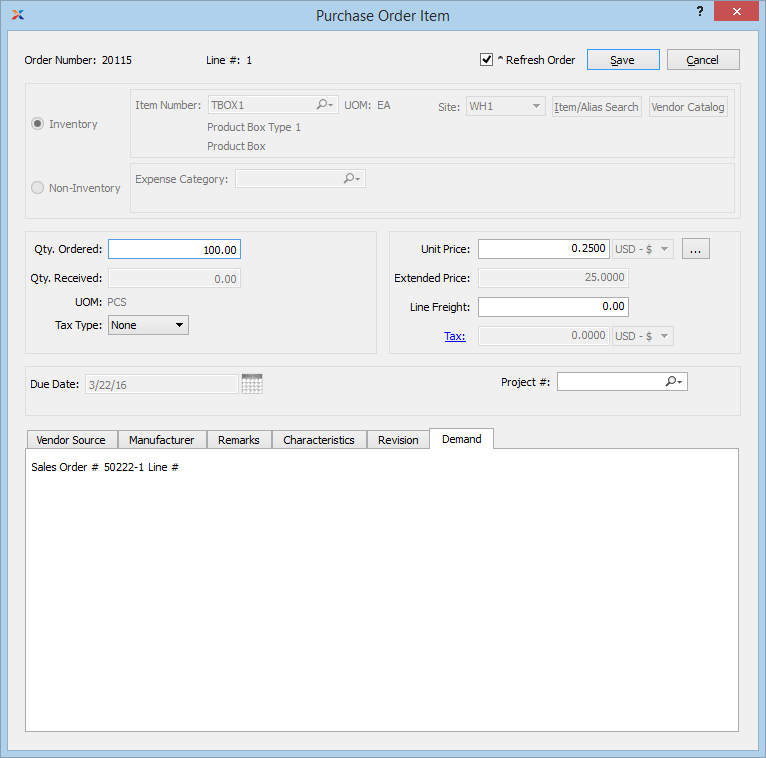
Displays information about the sales order or the work order the purchase order item is linked to. If the purchase order item is not linked, the tab will be disabled.